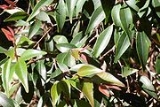
Uromyrtus australis
Encyclopedia
Uromyrtus australis, commonly known as the Peach Myrtle, is a small tree growing around Nightcap National Park
, New South Wales
, Australia
. It is endangered by extinction. The delicate foliage, pink flowers and appealing fruit makes this a particularly beautiful tree.
on warm temperate rainforest at an altitude of 400 to 770 metres above sea level. There are around 800 plants in the wild.
In November and December white flowers appear, turning deep pink. The fruit is black berry; globular in shape. 5 to 8 mm in diameter with one or two cells, with two seeds in each. Fruit is ripe from April to July. After removing the aril
, germination begins after two months without much difficulty.
Nightcap National Park
Nightcap National Park is in New South Wales, Australia, 35 km north of Lismore. It is classed by the IUCN World Commission on Protected Areas as Category II...
, New South Wales
New South Wales
New South Wales is a state of :Australia, located in the east of the country. It is bordered by Queensland, Victoria and South Australia to the north, south and west respectively. To the east, the state is bordered by the Tasman Sea, which forms part of the Pacific Ocean. New South Wales...
, Australia
Australia
Australia , officially the Commonwealth of Australia, is a country in the Southern Hemisphere comprising the mainland of the Australian continent, the island of Tasmania, and numerous smaller islands in the Indian and Pacific Oceans. It is the world's sixth-largest country by total area...
. It is endangered by extinction. The delicate foliage, pink flowers and appealing fruit makes this a particularly beautiful tree.
Distribution and habitat
Restricted range associated with a very high rainfall and CoachwoodCoachwood
Ceratopetalum apetalum, Coachwood, also called Scented Satinwood or Tarwood, is a medium-sized hardwood tree, straight-growing with smooth, fragrant, greyish bark. It is in the family Cunoniaceae...
on warm temperate rainforest at an altitude of 400 to 770 metres above sea level. There are around 800 plants in the wild.
Description
Uromyrtus australis reaches a height of 12 metres (40 ft) and a stem diameter of 15 cm (6 in). The bark is flaky or scaly, brown. Dead bark is thin. The trunk is cylindrical but often crooked. The leaves are opposite and entire, and measure 2.5 to 4.5 cm (1-1.8 in) long, tapering to a tip. Shiny above but dull beneath. Young leaf growth with white hairs, new leaves bright red. Oil dots obscure. Branchlets with white hairs, becoming smooth with age. The leaf stalks 2 to 3 mm long, silky hairs only on young leaves. Only the midrib is prominent on both surfaces, lateral veins obscure, raised above but sunken below. There is no intramarginal vein.In November and December white flowers appear, turning deep pink. The fruit is black berry; globular in shape. 5 to 8 mm in diameter with one or two cells, with two seeds in each. Fruit is ripe from April to July. After removing the aril
Aril
An aril is any specialized outgrowth from the funiculus that covers or is attached to the seed. It is sometimes applied to any appendage or thickening of the seed coat in flowering plants, such as the edible parts of the mangosteen and pomegranate fruit, the mace of the nutmeg seed, or the...
, germination begins after two months without much difficulty.

